Neiman Marcus 2003 Annual Report Download - page 9
Download and view the complete annual report
Please find page 9 of the 2003 Neiman Marcus annual report below. You can navigate through the pages in the report by either clicking on the pages listed below, or by using the keyword search tool below to find specific information within the annual report.-
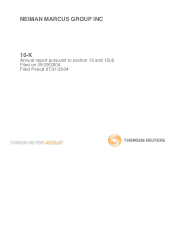 1
1 -
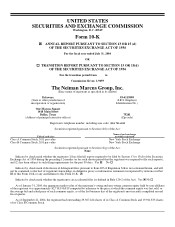 2
2 -
 3
3 -
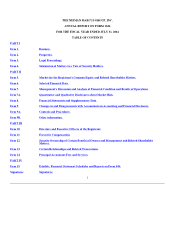 4
4 -
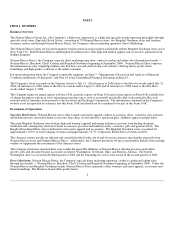 5
5 -
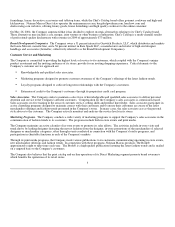 6
6 -
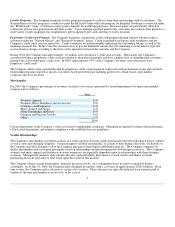 7
7 -
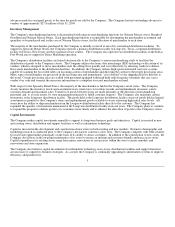 8
8 -
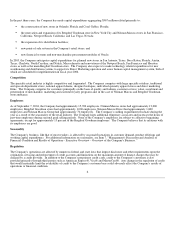 9
9 -
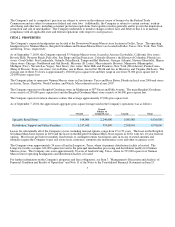 10
10 -
 11
11 -
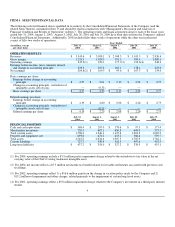 12
12 -
 13
13 -
 14
14 -
 15
15 -
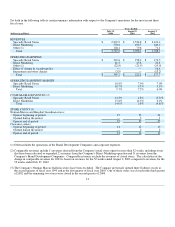 16
16 -
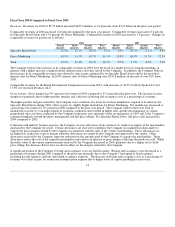 17
17 -
 18
18 -
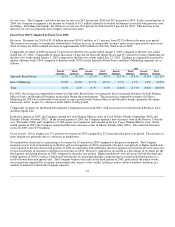 19
19 -
 20
20 -
 21
21 -
 22
22 -
 23
23 -
 24
24 -
 25
25 -
 26
26 -
 27
27 -
 28
28 -
 29
29 -
 30
30 -
 31
31 -
 32
32 -
 33
33 -
 34
34 -
 35
35 -
 36
36 -
 37
37 -
 38
38 -
 39
39 -
 40
40 -
 41
41 -
 42
42 -
 43
43 -
 44
44 -
 45
45 -
 46
46 -
 47
47 -
 48
48 -
 49
49 -
 50
50 -
 51
51 -
 52
52 -
 53
53 -
 54
54 -
 55
55 -
 56
56 -
 57
57 -
 58
58 -
 59
59 -
 60
60 -
 61
61 -
 62
62 -
 63
63 -
 64
64 -
 65
65 -
 66
66 -
 67
67 -
 68
68 -
 69
69 -
 70
70 -
 71
71 -
 72
72 -
 73
73 -
 74
74 -
 75
75 -
 76
76 -
 77
77 -
 78
78 -
 79
79 -
 80
80 -
 81
81 -
 82
82 -
 83
83 -
 84
84 -
 85
85 -
 86
86 -
 87
87 -
 88
88 -
 89
89 -
 90
90 -
 91
91 -
 92
92 -
 93
93 -
 94
94 -
 95
95 -
 96
96 -
 97
97 -
 98
98 -
 99
99 -
 100
100 -
 101
101 -
 102
102 -
 103
103 -
 104
104 -
 105
105 -
 106
106 -
 107
107 -
 108
108 -
 109
109 -
 110
110 -
 111
111 -
 112
112 -
 113
113 -
 114
114 -
 115
115 -
 116
116 -
 117
117 -
 118
118 -
 119
119 -
 120
120 -
 121
121 -
 122
122 -
 123
123 -
 124
124 -
 125
125 -
 126
126 -
 127
127 -
 128
128 -
 129
129 -
 130
130 -
 131
131 -
 132
132 -
 133
133 -
 134
134 -
 135
135 -
 136
136 -
 137
137 -
 138
138 -
 139
139 -
 140
140 -
 141
141 -
 142
142 -
 143
143 -
 144
144 -
 145
145 -
 146
146 -
 147
147 -
 148
148 -
 149
149 -
 150
150 -
 151
151 -
 152
152 -
 153
153 -
 154
154 -
 155
155 -
 156
156 -
 157
157 -
 158
158 -
 159
159 -
 160
160 -
 161
161 -
 162
162 -
 163
163 -
 164
164 -
 165
165 -
 166
166 -
 167
167 -
 168
168 -
 169
169 -
 170
170 -
 171
171 -
 172
172 -
 173
173 -
 174
174 -
 175
175 -
 176
176 -
 177
177 -
 178
178 -
 179
179 -
 180
180 -
 181
181 -
 182
182 -
 183
183 -
 184
184 -
 185
185 -
 186
186 -
 187
187 -
 188
188 -
 189
189 -
 190
190 -
 191
191 -
 192
192 -
 193
193 -
 194
194 -
 195
195 -
 196
196 -
 197
197 -
 198
198 -
 199
199 -
 200
200 -
 201
201 -
 202
202 -
 203
203 -
 204
204 -
 205
205 -
 206
206 -
 207
207 -
 208
208 -
 209
209 -
 210
210 -
 211
211 -
 212
212 -
 213
213 -
 214
214 -
 215
215 -
 216
216 -
 217
217 -
 218
218 -
 219
219 -
 220
220 -
 221
221 -
 222
222 -
 223
223 -
 224
224 -
 225
225 -
 226
226 -
 227
227 -
 228
228 -
 229
229 -
 230
230 -
 231
231 -
 232
232 -
 233
233 -
 234
234 -
 235
235 -
 236
236 -
 237
237 -
 238
238 -
 239
239 -
 240
240 -
 241
241 -
 242
242 -
 243
243 -
 244
244 -
 245
245 -
 246
246 -
 247
247 -
 248
248 -
 249
249 -
 250
250 -
 251
251 -
 252
252 -
 253
253 -
 254
254 -
 255
255 -
 256
256 -
 257
257 -
 258
258 -
 259
259 -
 260
260 -
 261
261 -
 262
262 -
 263
263 -
 264
264 -
 265
265 -
 266
266 -
 267
267 -
 268
268 -
 269
269 -
 270
270 -
 271
271 -
 272
272 -
 273
273 -
 274
274 -
 275
275 -
 276
276 -
 277
277 -
 278
278 -
 279
279 -
 280
280 -
 281
281 -
 282
282 -
 283
283 -
 284
284 -
 285
285 -
 286
286 -
 287
287 -
 288
288 -
 289
289 -
 290
290 -
 291
291 -
 292
292 -
 293
293 -
 294
294 -
 295
295 -
 296
296 -
 297
297 -
 298
298 -
 299
299 -
 300
300 -
 301
301 -
 302
302 -
 303
303 -
 304
304 -
 305
305 -
 306
306 -
 307
307 -
 308
308 -
 309
309 -
 310
310 -
 311
311 -
 312
312 -
 313
313 -
 314
314 -
 315
315 -
 316
316 -
 317
317 -
 318
318 -
 319
319 -
 320
320 -
 321
321 -
 322
322 -
 323
323 -
 324
324 -
 325
325 -
 326
326 -
 327
327 -
 328
328 -
 329
329 -
 330
330 -
 331
331 -
 332
332 -
 333
333 -
 334
334 -
 335
335 -
 336
336 -
 337
337 -
 338
338 -
 339
339 -
 340
340 -
 341
341 -
 342
342 -
 343
343 -
 344
344 -
 345
345 -
 346
346 -
 347
347 -
 348
348 -
 349
349 -
 350
350 -
 351
351 -
 352
352 -
 353
353 -
 354
354 -
 355
355 -
 356
356 -
 357
357
 |
 |

In the past three years, the Company has made capital expenditures aggregating $367 million related primarily to:
• the construction of new stores in Orlando, Florida and Coral Gables, Florida;
• the renovation and expansion of its Bergdorf Goodman store in New York City and Neiman Marcus stores in San Francisco,
California; Newport Beach, California; and Las Vegas, Nevada;
• the expansion of its distribution facilities;
• new point-of-sale system in the Company's retail stores; and
• new financial systems and non-merchandise procurement modules of Oracle.
In 2005, the Company anticipates capital expenditures for planned new stores in San Antonio, Texas; Boca Raton, Florida; Austin,
Texas; Charlotte, North Carolina; and Natick, Massachusetts and renovations of the Newport Beach, San Francisco and Houston
stores as well as the main Bergdorf Goodman store. The Company also expects to make technology related expenditures for new
warehousing and distribution systems to support its Direct Marketing operation and a new human capital management system, both of
which are scheduled for implementation in fiscal year 2006.
Competition
The specialty retail industry is highly competitive and fragmented. The Company competes with large specialty retailers, traditional
and upscale department stores, national apparel chains, designer boutiques, individual specialty apparel stores and direct marketing
firms. The Company competes for customers principally on the basis of quality and fashion, customer service, value, assortment and
presentation of merchandise, marketing and customer loyalty programs and, in the case of Neiman Marcus and Bergdorf Goodman,
store ambiance.
Employees
As of September 7, 2004, the Company had approximately 15,700 employees. Neiman Marcus stores had approximately 13,000
employees, Bergdorf Goodman stores had approximately 1,000 employees, Neiman Marcus Direct had approximately 1,600
employees and Neiman Marcus Group had approximately 70 employees. The Company's staffing requirements fluctuate during the
year as a result of the seasonality of the retail industry. The Company hires additional temporary associates and increases the hours of
part-time employees during seasonal peak selling periods. None of the Company's employees are subject to collective bargaining
agreements, except for approximately 15 percent of the Bergdorf Goodman employees. The Company believes that its relations with
its employees are good.
Seasonality
The Company's business, like that of most retailers, is affected by seasonal fluctuations in customer demand, product offerings and
working capital expenditures. For additional information on seasonality, see Item 7, "Management's Discussion and Analysis of
Financial Condition and Results of Operations - Executive Overview – Overview of the Company's Business. "
Regulation
The Company's operations are affected by numerous federal and state laws that impose disclosure and other requirements upon the
origination, servicing and enforcement of credit accounts and limitations on the maximum amount of finance charges that may be
charged by a credit provider. In addition to the Company's proprietary credit cards, credit to the Company's customers is also
provided primarily through third parties such as American Express®, Visa® and MasterCard®. Any change in the regulation of credit
that would materially limit the availability of credit to the Company's customer base could adversely affect the Company's results of
operations or financial condition.
6
